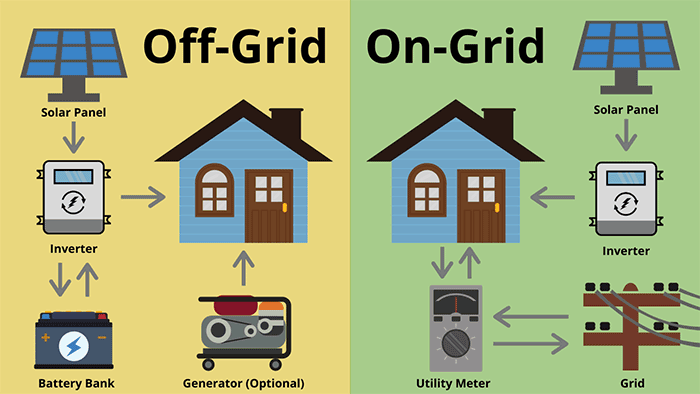
Solar power systems are becoming the go to energy source for homeowners, the number of people who have solar panels at their homes in the USA are increasing every year. In 2020, out of the total electricity produced in America, 2.3% of electricity was generated using solar power systems. By the end of the year, the USA grossed 97,275 megawatts (MW) of installed photovoltaic and concentrated solar power systems all over the country. With more and more people making the switch to solar energy, it is becoming very essential to spread awareness about the types of solar power systems. There are 3 types of solar energy systems that are installed in residential as well as commercial setups. In this article we talk in detail about the three types of solar power systems that can be installed at residential or commercial locations: grid-tied solar system, off-grid solar systems and hybrid solar systems. The three of them are distinguished on the basis of their setups, their advantages and disadvantages.
There is not a ‘one shoe fits all’ rule when it comes to solar power systems available in the market, you can choose the types of solar energy system that works best for you according to your energy usage, the amount of energy produced by the solar energy system. Each of the three solar power systems offer a unique power generation experience and facility to utilise the excessive solar power produced by the solar energy system.
Grid-tied solar system:
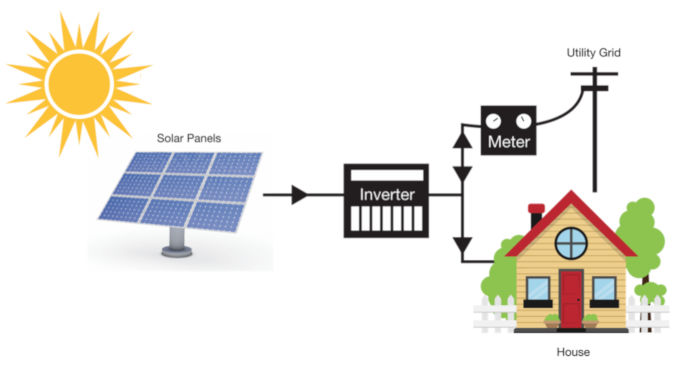
Grid tied solar system or on-grid solar energy system is connected to the local electricity grid. This means that the electricity that is produced by your solar panels will go back to the utility grid and be connected to it at all times. In case of the grid-tied solar systems you get an additional security that just in case your energy is not met by the solar panel, you will have another source to fall back on. Thus, in case the solar energy production is low on a bad weather day, you just simply tap into the grid to meet your energy requirements.
Solar energy seems like a very attractive option, especially when you are told that you will never have to pay for electricity if you have solar energy. While it might be true, it also depends upon whether or not you have a battery backup or another type of storage system installed. If you have solar panels installed, you might be in for a little bit of trouble. Since solar panels work on photovoltaic technology (converting sunlight directly into electricity), they work only as long as they receive sunlight. This means that when the sun goes down, so does your electricity production. And the time of the day when your electricity requirement is the most, you will have none. But this situation can be remedied it you have a grid-tied solar system.
How does a grid-tied solar power system work?
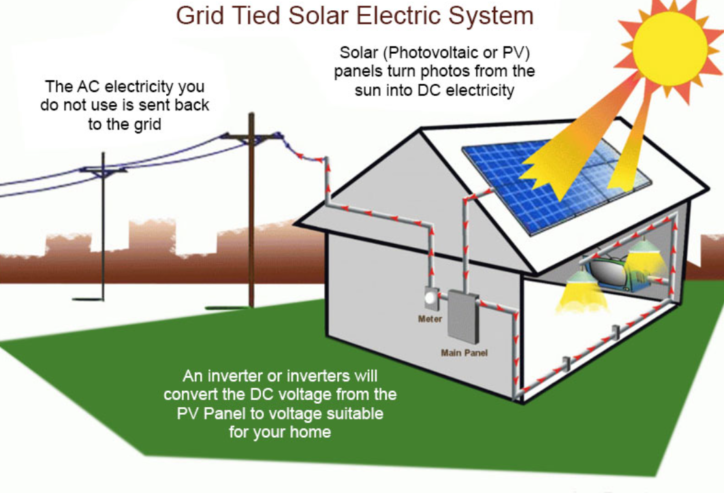
The grid-tied solar system is the most commonly used solar power system especially in case of homeowners. Because there is no need for a lot of additional equipment to install, it seems like a very economical and highly practical option for residential solar power systems. So how does a grid-tied solar system work? To put it in simple words, a grid-tied solar system works on the photovoltaic principle in a manner similar to how solar panels work. They convert the sunlight into direct current which is then converted to alternating current by passing it through an inverter, this inverter is connected to your house at one end and at the other end it is connected to a meter that is connected to the grid. The meter tracks the amount of electricity that flows in or out from the grid. (we discuss in detail about how the meter works later in this article).
The electricity that is produced by the solar system is routed to the grid which then supplies it to houses for day to day utilization.
What is net metering? What are the benefits that one can get through net metering?
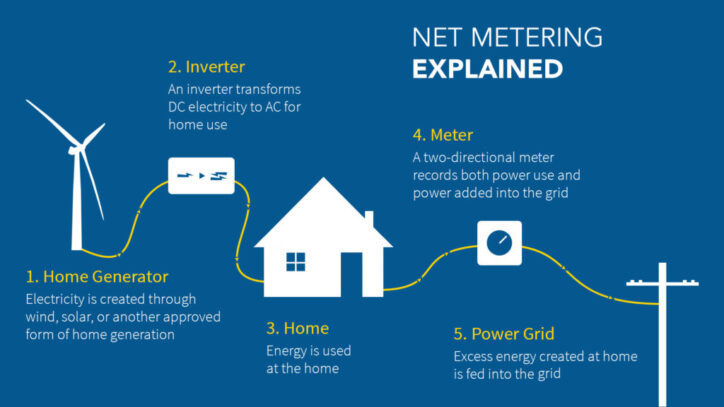
Remember we said that there is a meter involved in the entire grid-tied solar system setup? Well, here we will discuss in detail about the function of the net meter and the entire process of net metering.
In simple terms, the meter keeps a track of the amount of electricity that you either pull from the grid or the amount that you send into the grid and on the basis of this your electricity bill is generated. Net metering refers to the calculation of your electricity bills on the basis of the amount of electricity that you transferred to the grid as against the amount that you utilised from the grid. To understand this in a better way let us consider two scenarios.
You solar power system is producing more electricity than you need:
If you have a grid tied solar system, and your solar power system is creating more electricity than you need or can consume, the excessive electricity produced is simply sent into the power grid. When the electricity passes through the meter, the meter runs backwards. So, if your solar power system is producing more electricity than you consume, and the electricity is being sent back to the grid, you will get money for it because you are producing electricity and giving it to the state.
The meter records the amount of electricity that flows out to the grid and your power retailer will pay you for the electricity that you have exported.
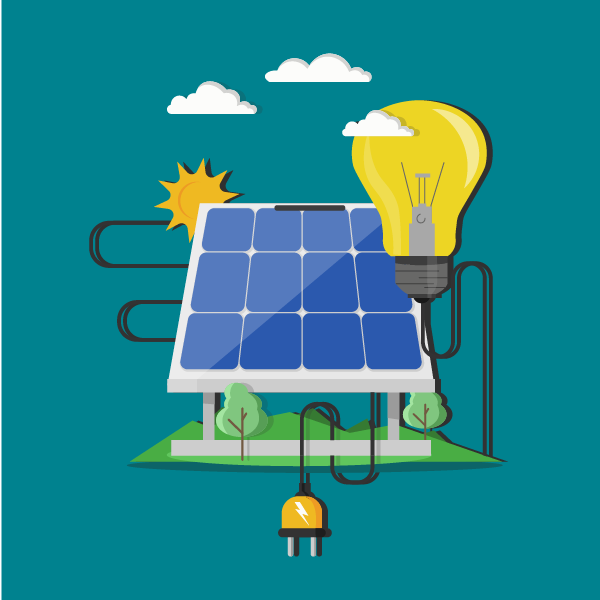
Your solar power panel is not producing a sufficient amount of electricity:
Let us face it, solar panels are not always going to produce the same amount of electricity everyday. One days when the sun is not shining as brightly or is not even visible, sometimes, it could happen that your solar power system is not able to fulfill your power usage needs. On days when the solar energy production is low, you would have to rely on the electricity from the grid in order to fulfill your power requirement. In this case the meter will record the amount of electricity that flows into your house from the meter, thus your meter will run forward. You will be charged for the amount of electricity that you utilize from the grid.
You won’t produce excessive electricity every day and you won’t be utilising grid energy all day, everyday, so your electricity bill will reflect the net amount of electricity that you’ve used from the grid, deducting the amount of electricity that you have transferred to the grid. Thus, in one billing cycle, if the amount of electricity that you utilised from the grid is more than the amount of electricity that you transferred to the grid, you will have to pay for it, on the other hand, if the amount that you exported to the grid is more than the amount that you consumed from the grid, you will be paid for it. This is called net metering.
Benefits of on-grid solar system:
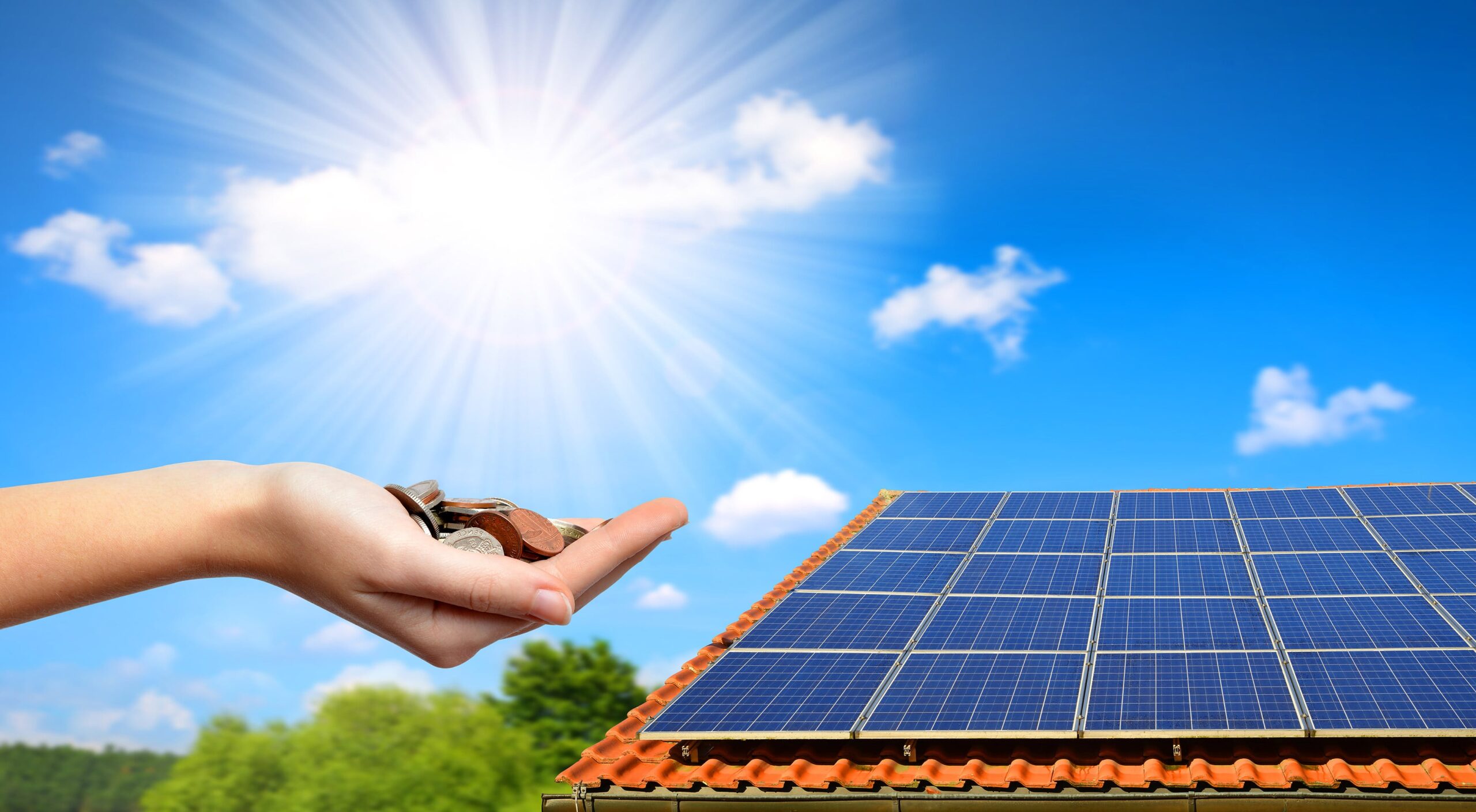
- Zero electricity bills: the biggest advantage is that the on-grid or grid-tied solar system allows you to eliminate your electricity bill to even zero. With the help of net metering you can keep a track of the amount of electricity that you use from the grid and the amount that you send back to the grid. If the consumption and production is equal, you need not pay even a penny for electricity.
- No hassles for additional equipment: another advantage when it comes to on-grid solar systems is that you need not install any additional equipment like a battery or other solar storage system to store the excessive solar energy. Nor do you have to worry about your energy requirements on days when the solar energy production is low. The on-grid system adds a sense of security and eliminates additional expenses.
- Get paid for using an on-grid solar system: we discussed the concept of net metering, wherein a track of your electricity generation and consumption is kept. If the amount of electricity that you send back to the grid exceeds the amount of electricity that you pull from the grid, you will end up getting paid. This adds on to your income. Thus a grid-tied solar system allows you to have passive earnings, without you having to do anything.
Off-grid solar system:
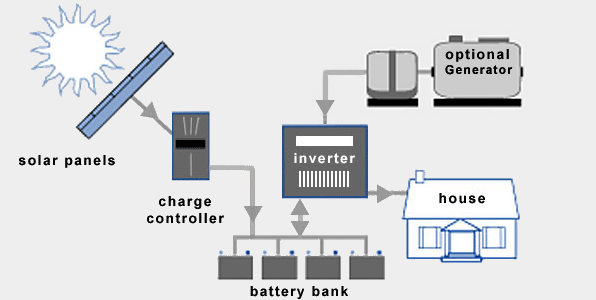
Off-grid solar systems are ideally used by commercial setups or mid to large sized houses. In the case of the off-grid solar system, the solar power system is not connected to the local power grid, instead the system is equipped with its own solar storage system like a battery in order to store excessive electricity produced by the solar panels and store it for later use. The off grid solar power system consists of solar panels, battery, charge controller, grid box, inverter, mounting structure and balance of systems.
The off grid solar system is self-sustaining as it is equipped with a storage facility. It can provide electricity in areas where the power grid is not available or accessible.
What do I need for an off-grid solar power system?
In order to go off-grid with a solar power system, you need to install a few additional pieces of equipment. You would need a specific type of off-grid solar system you would require deep cycle batteries as well as backup energy supplies in order to have your own energy source:
1 ) When the production of electricity exceeds your consumption, the extra electricity produced needs to be stored, this would need a battery bank. The battery bank will enable you to store the excessive electricity during peak production hours, and utilize it later when the production is low and the consumption is high.
2 ) In addition to the battery bank, you also need a backup generator to complete your off-grid solar system. During the times when the solar energy is low because of the weather conditions, even your solar battery wouldn’t last for too long, in this case you would require a backup generator that can fulfill your power needs as well as charge the batteries for you to use the power.
The battery used in case of off-grid solar power systems needs to be larger than that used in case of grid-tied systems. This is because in case of the off-grid solar system, the battery acts as the sole power backup system. While in the grid-tied solar system, you still have the grid power as a source of backup.
Advantages of off-grid solar systems:
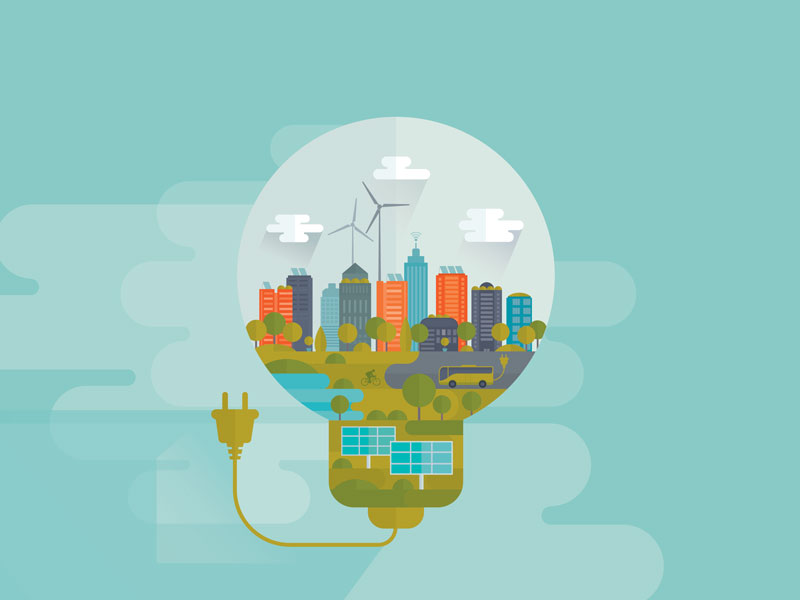
- Off- grid solar systems are self-sustaining energy sources: in case of the off-grid solar system, you do not have to be dependent in any way on any external source of energy like the power grid. Having a battery bank as well as a backup generator allows you to be completely self-sustaining in fulfilling your energy needs. You can be completely in control of your electricity bills in this manner.
- Zero electricity bills: since you are in no way dependent upon grid power, you will literally have zero electricity bill. In case of grid-tied solar system, there is still a scope for you to get an electricity bill because you would pull power from the grid, but in case of off-grid solar system, you do not need to pull power from the grid, because you have a battery bank as well as a backup generator to support your energy requirements.
- Can be provided for remote areas as well: in areas where the power grid is not available or it is very unreliable, off-grid solar systems become the ideal choice. In case of a grid-tied solar system,if there are a number of outages in the power grid, you would not have a dependable source of energy even if you have solar panels installed at your home. A truly reliable source is the off-grid solar system that gives you power backup in the form of batteries.
Disadvantages of off-grid solar system
While off-grid solar systems afford a number of advantages, they also have a few disadvantages that are worth taking a look at.
- More expensive than grid-tied solar systems: since the off-grid system requires additional equipment to be installed, it becomes more expensive to install than the grid-tied solar system.
- More tedious to install: because the off-grid solar system needs a number of different equipment, it becomes more tedious to install. It is more time consuming and takes a lot of work.
- Limited power backup: the off grid power system needs a bigger battery bank than does an on-grid solar system. Even then, the battery bank cannot sustain the power usage. At best, a battery can sustain the house for a few hours. Thus, the off-grid system also needs a backup generator. Thus the off-grid solar system has a limited capacity to generate power.
Off grid systems are not opted for homeowner as they are highly costly and do not seem worth the additional cost, especially considering that even after spending a tonne of money on installation of battery bank, you still have to go for a backup generator because the battery would not be able to provide for the power usage for too long.
Hybrid solar system:
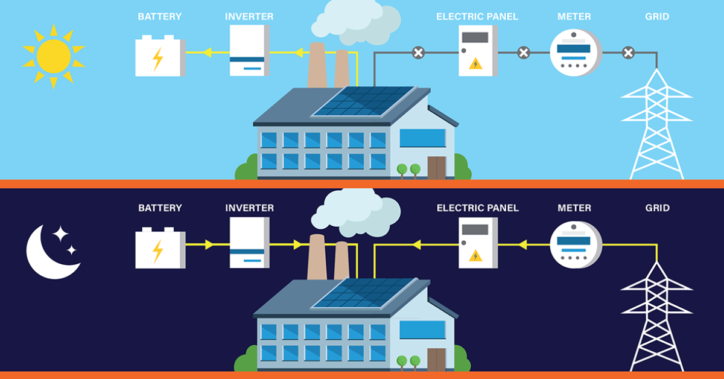
Hybrid solar systems offer you the best of both worlds, in case of hybrid solar systems the solar panel comes equipped with a hybrid inverter and batteries so that it can store the excessive electricity for later use. They work in a way similar to grid- tied systems. This means that the hybrid solar system is connected to the electricity grid in case there is a black out in your area or the power grid is insatiable, hybrid system is the perfect fit for you. The hybrid solar system operates as a backup power supply during blackouts, it is similar to a UPS System.
Hybrid systems are the most flexible option for solar power users, using hybrid the solar energy users have the option to either draw energy from the grid or from the battery storage, whenever the production is low and the consumption is high.
When you have a hybrid solar system, you can earn from net metering, this way you can easily send the power back to the grid and get paid for the amount of electricity that you send out. In case your local municipality does not offer a net metering system, it may be a good idea to go for a hybrid solar system. Hybrid system gives you a double surety in that, even if you run your battery down to its limit, you would still have battery backup from the grid. Consequently, if there is grid failure, you would have a battery backup to rely upon.
A battery ready solar system:
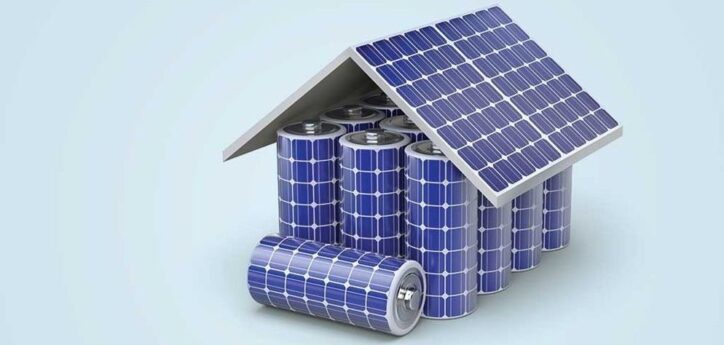
A battery ready solar system uses a hybrid inverter instead of a typical string solar inverter. Usually a hybrid inverter comes with a battery charger and built in connection that allows you to add a battery much easier in the future. However, it is a better choice to add batteries at the time of installation, otherwise the cost of installation can be pretty hefty. Besides, with the rapid advancement in technology, who is to say which technology becomes outdated, you might even have to upgrade the entire solar power system just because you could not find the suitable battery for your hybrid solar power system.
You don’t need a hybrid inverter specifically to add a battery to your solar power system. You can add a backup battery to an already existing grid-tied system as well. This battery is known as an AC battery system, like Tesla Powerwall 2. Considering that the inverter technology is evolving rapidly, it might not be a very good option to purchase a ‘battery ready system’ unless you want to buy a battery within a period of two years from the installation. The battery ready system would require more money and might not be worth it considering that there is no guarantee on which kind of technology may come up in the coming few years. Thus, waiting too long to add a battery in the battery ready system might result in you wasting your money, because by the time you decide to purchase the compatible battery, the system itself may become obsolete and you might not be able to find the battery in the market.
In case you are not sure about the kind of solar system you should opt for, you do not have to worry, you can always seek advice from solar companies. There are several solar companies in the USA which provide solar installation at competitive prices. You can find the best solar companies in your region with the help of Sun Solar.
